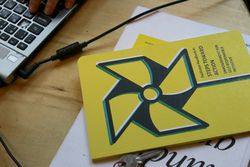Difference between revisions of "Social Skills"
From Competendo - Digital Toolbox
(→Facilitating Conflict Management) |
|||
| Line 6: | Line 6: | ||
In this section you will not only get to know ideas how to work with conflicts, how to solve them or how to reflect on them. You will even get ideas how to start them... | In this section you will not only get to know ideas how to work with conflicts, how to solve them or how to reflect on them. You will even get ideas how to start them... | ||
<div class="mw-collapsible mw-collapsed" data-expandtext="What's inside?"> | <div class="mw-collapsible mw-collapsed" data-expandtext="What's inside?"> | ||
| − | |||
| − | |||
| − | |||
| − | |||
| − | |||
| − | |||
| − | |||
<div class="teaser-box"> | <div class="teaser-box"> | ||
=== [[What is a Conflict?]]=== | === [[What is a Conflict?]]=== | ||
| Line 67: | Line 60: | ||
=== [[The Dilemma Exercise]]=== | === [[The Dilemma Exercise]]=== | ||
[[File:Method.png | left]]Through bringing the participants face to face with various controversial issues this method fosters deep and engaging discussions | [[File:Method.png | left]]Through bringing the participants face to face with various controversial issues this method fosters deep and engaging discussions | ||
| + | </div> | ||
| + | |||
| + | |||
| + | |||
| + | <div class=teaser-box> | ||
| + | ===[[The ABC Triangle]]=== | ||
| + | [[File:Method.png | left]]This analysis is based on the premise that conflicts have three major components: the context or situation, the behaviour of those involved and their attitudes. | ||
| + | </div> | ||
| + | |||
| + | <div class=teaser-box> | ||
| + | ===[[The Onion]]=== | ||
| + | [[File:Method.png | left]]The method is based on the analogy of an onion and its layers in a conflict: our public positions, our interests and our needs. | ||
| + | </div> | ||
| + | |||
| + | <div class=teaser-box> | ||
| + | |||
| + | ===[[Five Conflict Solutions]]=== | ||
| + | [[File:Method.png | left]]So far there are five ways for solving conflicts. You can reflect on your own pattern when it comes to conflict behavior. </div> | ||
| + | |||
| + | <div class=teaser-box> | ||
| + | ===[[Personal Conflict History]]=== | ||
| + | [[File:Method.png | left]]The principle of timeline is very simple: it is a graphic showing events plotted against time. | ||
</div> | </div> | ||
Revision as of 13:04, 10 January 2019
Contents
- 1 Facilitating Conflict Management
- 1.1 What is a Conflict?
- 1.2 Reflecting Behaviour in Conflict Situations
- 1.3 Dealing with personal anger
- 1.4 Techniques to Deal with Conflicts in a Team
- 1.5 Harvard Conflict Resolution Method
- 1.6 Conflict Map
- 1.7 Authorities
- 1.8 Forum Theatre
- 1.9 Conflict tree
- 1.10 The Dilemma Exercise
- 1.11 The ABC Triangle
- 1.12 The Onion
- 1.13 Five Conflict Solutions
- 1.14 Personal Conflict History
- 1.15 Communication Skills
- 2 Language & Understanding
Facilitating Conflict Management
In this section you will not only get to know ideas how to work with conflicts, how to solve them or how to reflect on them. You will even get ideas how to start them...
Communication Skills
Here you find practical methods to use for training communication skills in your events
Language & Understanding
Check Out Our Handbooks
The handbooks for facilitators contain the best of Competendo. Download and read them here: more




